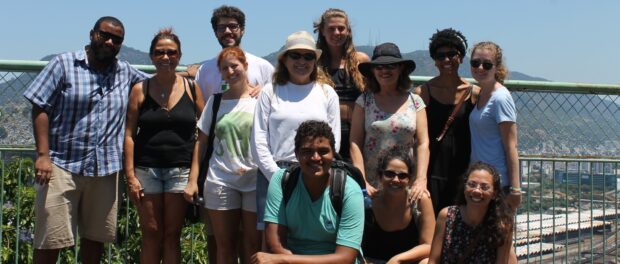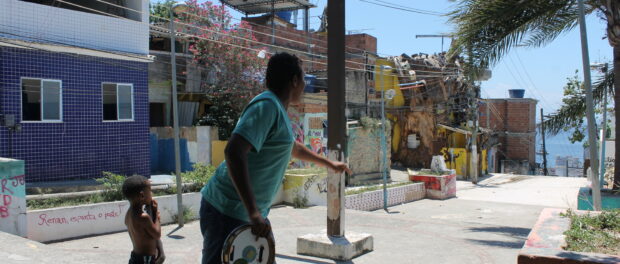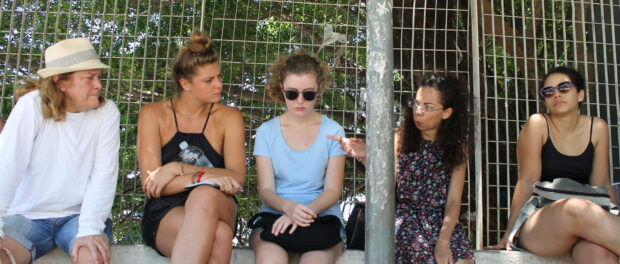
The second installment of Rolé dos Favelados (Stroll of the Favelados) kicked off this Saturday, February 18 in the downtown favela of Providência, which will celebrate its 120th anniversary this year. Amid a backdrop of party goers and street vendors from across Greater Rio disembarking at the Central Station and heading toward pre-carnival events taking place throughout the city, a group of eleven visitors–Rio natives and international residents of the city–met guide Cosme “O Favelado” Felippsen and community journalist Gizele Martins for a tour of Providência, Rio’s first favela.
The tour emerged from both Felippsen and Martins’ work as community activists dedicated to combating the stigmatization of Rio’s favelas. Felippsen, who has a degree in tourism, recognized the need to change the negative perceptions that non-residents have of favelas when he began his career as a tour guide at the young age of eight, when Providência celebrated its 100th anniversary and visitors with the Methodist Church in the nearby Saúde neighborhood would pay him with popsicles for tours around the hillside favela.
Martins, a community journalist from the North Zone favela complex of Maré who has studied oral history and is currently working on a Masters in Urban Peripheries at the University of the State of Rio de Janeiro’s Department of Education of the Baixada Fluminese in Duque de Caxias, sees the tour as an opportunity for favela residents to disprove the negative stereotypes that dominate media and policymakers’ narratives about favelas and their often poor, black residents. “We want to tell our story ourselves, we want to use our own references, our own language, so visitors get a sense of what we go through and suffer,” she stated early on in the tour.
The idea of the Rolé dos Favelados is for the two to lead tours in a number of favelas with local guides and activists. They plan to host two tours in March in Santa Marta and Maré in order to show both local and foreign visitors alike that while Rio’s 1000 favelas share characteristics, they exhibit a rich socio-historical and cultural variety and currently face different forms of state and market-driven oppression, such as forced eviction, police occupation and brutality, and gentrification.
The tour is intentionally participatory and didactic. In Providência, the tour began on Ladeira do Barroso, an uphill road lined with colonial Portuguese architecture known for being the childhood birthplace and home of famed Brazilian author Machado de Assis. Felippsen started the tour by asking everyone in the group whether that specific place was a favela. Answers varied since the site lacked the self-constructed homes, businesses, and roads associated with most favelas, but Felippsen used the opportunity to underscore the social dynamics that exist within favelas: “Residents here won’t say this is a favela, but traffickers pass by here, and residents higher up say it is part of the same hill. Many people here used to live higher up because the dream is to go down the hill.” Access to basic necessities, such as sewage and paved roads, not only mark the boundaries between the morro e aslfato (the ‘hill’ and the ‘asphalt,’ or the favela and the serviced city) but also the boundaries between those who have managed to move up the social ladder by moving down the physical hill.
Felippsen then asked the group what is a favela, to which Martins gave a historically, politically, and personally informed answer: “The favela is the act of building. It’s not just the fact that we build our own homes. We are the bus drivers, the waiters, the nannies, the people who work without documentation so that the city as a whole can function. We built everything. Nothing here was given [to us]. The black population never received reparations. So they went to the quilombo, and the favela is the urban quilombo.” She went on to express her frustration at the state’s one-sided public “insecurity” approach to favelas, which she experienced first-hand during the military occupation of Maré ahead of the 2014 World Cup: “The state enters to kill people. They do this to control [marginalized] people. Society calls us minorities. The LGBT minority, the Black minority, the indigenous minority, because if we knew that we are the majority this system would break.”
Though Felippsen admitted to asking the question because he himself had not yet reached a definitive conclusion, his answer was equally poignant: “Favelas are the solution. Here the favela was the housing that was promised to the soldiers returning after the Canudos War but which they never received [and so occupied the hill]… It’s the government that says they are the problem.”
Though like any traditional tour Felippsen highlighted important sites throughout the favela, the tour centered around the issues that both guides had faced as residents. Felippsen focused on the evictions that took place in Providência due to the construction of the currently non-operational cable car that was built in 2013 to connect the hill to the Central Station. Largely driven by real estate speculation due to the city’s Marvelous Port program to revitalize the Port Zone, an important site of Afro-Brazilian history and culture, the construction of the cable car removed 200 houses. Prior to the evictions, city official marked those slated for destruction with the infamous letters SMH and a number. Though SMH stands for Secretaria Municipal de Habitação (Municipal Housing Secretariat), residents angrily joked that letters meant sai na mesma hora (leave right now) and sai do morro hoje (leave the hill today).
Felippsen even sang his own version of samba composer Ze Keti’s “Opinião,” modifying the famous lyrics, “daqui do morro eu não saio não” (from this hill, I’m not leaving) with the names of favelas that have recently experienced state violence: “Da Vila Autódromo eu não saio não, da Maré eu não saio não, do Alemão eu não saio não, da Providência eu não saio não.”
Martins drove home for the visitors the extent of the structural and physical violence that the Pacifying Police Units have wrought on favela residents: “We ask for water, electricity, education, rights. We don’t ask for police; we ask for security, which are two different things.” She spoke frankly about how both the police and the military harass, harm, rape, and kill favela residents with impunity. Felippsen believes that the 2010 installation of the UPP in Providência was part of a strategic plan of the city to control and terrify residents: “They placed 200 police officers here. What if that had been doctors and teachers?”
A unique goal of this tour is to reach cariocas (Rio natives)–not just international tourists–who might never have set foot in a favela in their own city. Carolina, a public policy researcher at Fundação Getúlio Vargas (Getúlio Vargas Foundation-FGV) and resident of Botafogo, said she and her boyfriend Daniel had already been to Santa Marta due to its proximity to her home, but that this was their first favela tour. “[Tours] are a delicate issue,” she said. “You don’t want it to be like you’re going to a zoo to observe poverty. But because the mentality has always been to hide the favela, [the tour] shows that the favela is part of the city. It proves that it is an important, relevant, interesting part of the city.”
Ultimately the tour serves as yet another example of resistance. Lamenting that the UPPs have prohibited many cultural expressions in favelas, from forró to baile funks, Martins stressed that the favela is not something to be neglected and then consumed for the benefit of non-residents: “Police enter and prohibit the things that we produce and that now others consume. We [in the favela] breathe resistance in education, in culture.”



